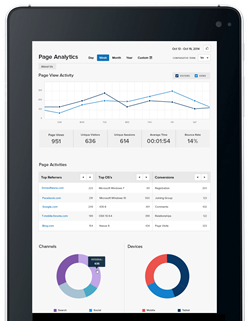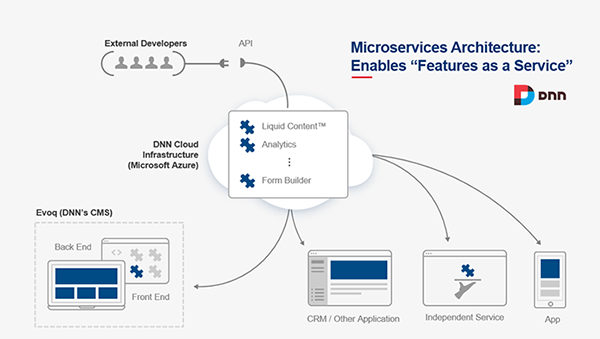DNN Moves to Decoupled CMS with the Release of Evoq 9
DNN, enterprise content management system provider, announces the general availability of Evoq 9 and moves from a monolithic Evoq content management system to a microservices, cloud-based, 'features as a service' architecture.
CMS-Connected has reached out to Joe Brinkman, Co-Founder, VP of Technology and Community Relations at DNN Corp., to inquire about what the new content delivery and presentation features of the Evoq CMS mean for the future of content management. He expressed how excited they are about the new Liquid Content feature as it speaks directly to what they believe is the future of content management. “The website is the centerpiece for your content today, but that may change in a year, two years, or five years. With Liquid Content™, we help organizations take their content wherever it needs to be, from websites to microsites, from apps to Internet of Things. In addition, we’re delivering all our new features “as a service” via a microservices architecture. This helps customers focus less on keeping software current and more on delivering value to end users,” stated Brinkman.
at DNN Corp., to inquire about what the new content delivery and presentation features of the Evoq CMS mean for the future of content management. He expressed how excited they are about the new Liquid Content feature as it speaks directly to what they believe is the future of content management. “The website is the centerpiece for your content today, but that may change in a year, two years, or five years. With Liquid Content™, we help organizations take their content wherever it needs to be, from websites to microsites, from apps to Internet of Things. In addition, we’re delivering all our new features “as a service” via a microservices architecture. This helps customers focus less on keeping software current and more on delivering value to end users,” stated Brinkman.
So let’s look at what is included in Liquid Content:
-
A headless CMS to manage content
-
A content analytics application to measure and analyze the impact of content
-
A stateless API to access and retrieve content
-
Delivery of services via Liquid Content™ Cloud, powered by Microsoft Azure
-
The content delivery and presentation features of the Evoq CMS, including a library of 100+ visualizers
Last Friday, here at CMS-Connected, I discussed the headless CMS approach from every angle in my article entitled The Ultimate Guide for Headless Content Management Systems, and stated that headless CMS offers new technologies for creating rich web and mobile experiences and unleashes the creative power of front-end developers but, comes at the price of sophisticated front-end development skills and experience. However, with its newly announced Evoq 9 product, DNN enables users to deliver content without writing a single line of code. “Evoq is the head that’s attached to the headless CMS of Liquid Content™. Customers will receive all of the content delivery and presentation features they’ve come to expect, along with visualizers and other new features,” said Navin Nagiah, President and CEO at DNN.
Now that content is separated from layout, the repurposing and reuse of content to multiple sites, devices, apps and distribution channels are easier with the Evoq 9 ECMS. To that point, the platform provides a stateless API that allows users to access and retrieve content and delivery of services through DNN's Liquid Content Cloud, powered by Microsoft Azure. On a related note, Navin Nagiah explained the impact of the new product on the repurposing and reuse of content with an interesting analogy: “Liquid takes the shape of the objects it’s placed in and flows around barriers and obstacles. Our vision with Evoq 9 is to transform your content into liquid. Your content becomes fluid and adaptable, and can easily be published to any channel.”
There is more good news that will make users happy. Now that all Liquid Content features are delivered as microservices, DNN said that they can publish weekly or daily updates to individual features. All customers will receive updates instantaneously, which provides enhancements and fixes as quickly as possible. Here are some other new features that come with Evoq 9:
-
Content localization was simplified, and redundancies were removed. Content localization now occurs at the page level.
-
New Evoq Analytics service replaces the old built-in analytics functionality. The new service connects to Google Analytics and displays visualizations, data, and insights inside the Evoq interface. The redesigned Analytics are the feature that Will Morgenweck, Vice President of Product Management at DNN, is most excited about. He said in an interview: “We redesigned our analytics system to leverage data from Google Analytics. Customers will have a consistent data story between Evoq and Google Analytics, but still have the ease-of-use of our in-page analytics, directly in Evoq.”
to Google Analytics and displays visualizations, data, and insights inside the Evoq interface. The redesigned Analytics are the feature that Will Morgenweck, Vice President of Product Management at DNN, is most excited about. He said in an interview: “We redesigned our analytics system to leverage data from Google Analytics. Customers will have a consistent data story between Evoq and Google Analytics, but still have the ease-of-use of our in-page analytics, directly in Evoq.”
-
As a part of the new Form Builder feature, you can configure the properties (custom URL) and custom connections (Google Analytics) of a form. Form Builder is the feature that Ash Prasad, Director of Engineering at DNN, is most excited about. In the same interview, he said: "Form Builder is a game-changer for Evoq. It has an intuitive and modern UI to design forms. You can embed forms outside of Evoq, just like you’d embed a YouTube video. Similarly, once a form is created, it can be posted on any of your web properties independent of Evoq."
-
Site Groups was folded into Site Management. The Site Groups module now displays a snapshot of each portal’s home page as a thumbnail card.
-
The new MailChimp connector allows new users or subscribers to be automatically mapped to your MailChimp subscription lists. The connector also includes an Unsubscribe module for users to be automatically removed if they opt out.
When it comes to security and performance, the engineering team in DNN is very cautious. They have bots running in their labs in order to do performance and stress testing on all of their products. As a result, they examine every code change to see whether it made the product faster or slower. They also observe response times visually. They run tests on both faster and slower hardware to see how the product behaves. Heavy loads like millions of users, files, folders are also simulated by the team in order to make the platform scalable.

Gartner cited in its most recent Magic Quadrant for Web Content Management report: “Microservices with a high level of interoperability will enable WCM elements to be coupled with different sets of third-party technologies, depending on the requirements of the current phase of the customer's journey.” Additionally, in Forrester’s report entitled The Rise of the Headless Content Management System, analysts Ted Schadler and Mark Grannan predicted: “Even if web CMS or eCommerce vendors are not going to relinquish control of the presentation layer to a dynamic JavaScript framework like Angular, they will be forced to publish new stateless APIs to deliver content everywhere. Doing this properly will take the vendors years and cost millions or tens of millions of development dollars.”
In the light of these two very prominent publications’ comments on the future of WCM and the role of microservices in there, it is safe to say DNN is heading the right direction by converting its platform from a traditional, monolithic architecture to one that is cloud-first, based on containers and microservices.

Venus Tamturk
Venus is the Media Reporter for CMS-Connected, with one of her tasks to write thorough articles by creating the most up-to-date and engaging content using B2B digital marketing. She enjoys increasing brand equity and conversion through the strategic use of social media channels and integrated media marketing plans.